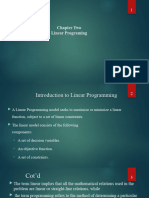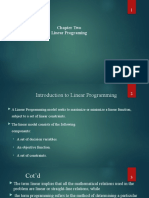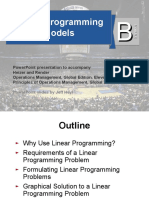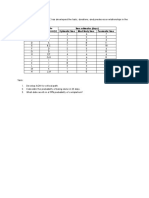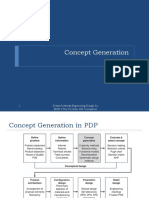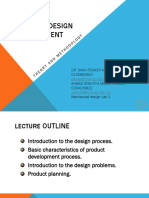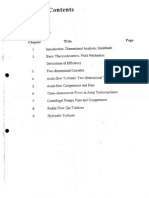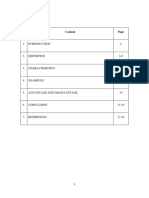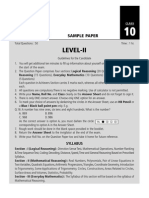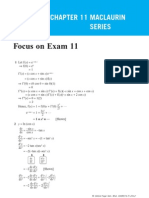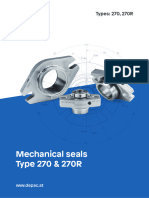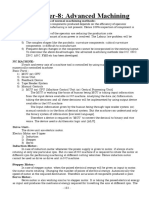Learning Objectives: Linear Programming
Uploaded by
Seng SoonLearning Objectives: Linear Programming
Uploaded by
Seng Soon8/20/2014
Learning Objectives
Linear Programming
3 When you complete this module you
should be able to:
1. Formulate linear models and interpret
sensitivity analysis.
2. Evaluate optimization problems based
PowerPoint presentation to accompany
Heizer and Render on linear programming models.
Operations Management, Global Edition, Eleventh Edition
Principles of Operations Management, Global Edition, Ninth Edition
PowerPoint slides by Jeff Heyl
© 2014
© 2014
Pearson
Pearson
Education
Education 3-1 © 2014 Pearson Education 3-2
Case study of LP Fast TrackTM
▶ Formulating LP Problems
Case 01 Case 02
▶ Graphic solution
▶ Corner-Point Method
▶ Sensitivity analysis
© 2014 Pearson Education 3-3 © 2014 Pearson Education 3-4
0:20:38 0:16:40
Why Use Linear Programming? LP Applications
▶ A mathematical technique to help plan
1. Scheduling school buses to minimize total
and make decisions relative to the distance traveled
trade-offs necessary to allocate
resources 2. Allocating police patrol units to high crime
areas in order to minimize response time
▶ Will find the minimum or maximum to 911 calls
value of the objective 3. Scheduling tellers at banks so that needs
▶ Guarantees the optimal solution to the are met during each hour of the day while
model formulated minimizing the total cost of labor
© 2014 Pearson Education 3-5 © 2014 Pearson Education 3-6
ENT 457/3 SEM 01 2014/15 1
8/20/2014
LP Applications LP Applications
4. Selecting the product mix in a factory to 7. Developing a production schedule that will
make best use of machine- and labor- satisfy future demands for a firm’s product
hours available while maximizing the and at the same time minimize total
firm’s profit production and inventory costs
5. Picking blends of raw materials in feed 8. Allocating space for a tenant
mills to produce finished feed mix in a new shopping mall
combinations at minimum costs so as to maximize
revenues to the
6. Determining the distribution system that leasing company
will minimize total shipping cost
© 2014 Pearson Education 3-7 © 2014 Pearson Education 3-8
Requirements of an Requirements of an
LP Problem LP Problem
1. LP problems seek to maximize or 3. There must be alternative courses of
minimize some quantity (usually action to choose from
profit or cost) expressed as an 4. The objective and constraints in
objective function linear programming problems must
2. The presence of restrictions, or be expressed in terms of linear
constraints, limits the degree to equations or inequalities
which we can pursue our objective
© 2014 Pearson Education 3-9 © 2014 Pearson Education 3 - 10
Formulating LP Problems Formulating LP Problems
▶ Glickman Electronics Example TABLE B.1 Glickman Electronics Company Problem Data
HOURS REQUIRED TO PRODUCE
ONE UNIT
► Two products AVAILABLE HOURS
DEPARTMENT X-PODS (X1) BLUEBERRYS (X2) THIS WEEK
1. Glickman x-pod, a portable music Electronic 4 3 240
player Assembly 2 1 100
2. Glickman BlueBerry, an internet- Profit per unit $7 $5
connected color telephone
Decision Variables:
► Determine the mix of products that will
X1 = number of x-pods to be produced
produce the maximum profit
X2 = number of BlueBerrys to be produced
© 2014 Pearson Education 3 - 11 © 2014 Pearson Education 3 - 12
ENT 457/3 SEM 01 2014/15 2
8/20/2014
Formulating LP Problems Formulating LP Problems
Objective Function: First Constraint:
Maximize Profit = $7X1 + $5X2 Electronic Electronic
is ≤
time used time available
There are three types of constraints
4X1 + 3X2 ≤ 240 (hours of electronic time)
► Upper limits where the amount used is ≤ the
amount of a resource
Second Constraint:
► Lower limits where the amount used is ≥ the
amount of the resource Assembly Assembly
time used is ≤ time available
► Equalities where the amount used is = the
amount of the resource 2X1 + 1X2 ≤ 100 (hours of assembly time)
© 2014 Pearson Education 3 - 13 © 2014 Pearson Education 3 - 14
Graphical Solution Graphical Solution
▶ Can be used when there are two decision
X2
variables 100 –
–
1. Plot the constraint equations at their limits by
Number of BlueBerrys
80 – Assembly (Constraint B)
converting each equation to an equality –
60 –
2. Identify the feasible solution space –
3. Create an iso-profit line based on the 40 –
Electronic (Constraint A)
–
objective function Feasible
20 –
region
4. Move this line outwards until the optimal –
point is identified |– | | | | | | | | | |
X1
0 20 40 60 80 100
Figure B.3 Number of x-pods
© 2014 Pearson Education 3 - 15 © 2014 Pearson Education 3 - 16
Graphical Solution Graphical Solution
X2 X2
Iso-Profit Line Solution Method
100 – 100 –
Choose a –possible value for the objective –
function80 –
Number of BlueBerrys
Number of BlueBerrys
Assembly (Constraint B) 80 –
– –
60 –
$210 = 7X1 + 5X2 60 – $210 = $7X1 + $5X2
– –
(0, 42)
Solve for
40 the
– axis intercepts of the function and 40 –
plot the line
– Electronic (Constraint A) –
20 – Feasible 20 – (30, 0)
– X2 = 42
region X1 = 30 –
|– | | | | | | | | | | X1 –
| | | | | | | | | | |
X1
0 20 40 60 80 100 0 20 40 60 80 100
Figure B.3 Number of x-pods Figure B.4 Number of x-pods
© 2014 Pearson Education 3 - 17 © 2014 Pearson Education 3 - 18
ENT 457/3 SEM 01 2014/15 3
8/20/2014
Graphical Solution Graphical Solution
X2 X2
100 – 100 –
– $350 = $7X1 + $5X2 – Maximum profit line
Number of BlueBerrys
Number of BlueBerrys
80 – 80 –
$280 = $7X1 + $5X2
– –
60 – $210 = $7X1 + $5X2 60 – Optimal solution point
– – (X1 = 30, X2 = 40)
40 – 40 –
– $420 = $7X1 + $5X2 – $410 = $7X1 + $5X2
20 – 20 –
– –
|– | | | | | | | | | |
X1 |
– | | | | | | | | | |
X1
0 20 40 60 80 100 0 20 40 60 80 100
Figure B.5 Number of x-pods Figure B.6 Number of x-pods
© 2014 Pearson Education 3 - 19 © 2014 Pearson Education 3 - 20
Corner-Point Method Corner-Point Method
X2 2 X
► The optimal value will always be at a corner
100 – point 100 –
2 – 2 –
► Find the80 objective function value at each
Number of BlueBerrys
Number of BlueBerrys
80 – –
– corner point
– and choose the one with the
60 – highest60profit
–
– –
3 3
40 – 40 –
–
Point 1 : (X1 –= 0, X2 = 0) Profit $7(0) + $5(0) = $0
20 – Point 2 : (X = 0, X2 = 80)
201 – Profit $7(0) + $5(80) = $400
– –
|–
Point 4 : (X1 |= 50, X| 2 =| 0) Profit $7(50) +| $5(0) = $350
1 –
| | | | | | | | | | | | | | | | |
1 X1 X1
0 20 40 60 80 100 0 20 40 60 80 100
4 4
Figure B.7 Number of x-pods Figure B.7 Number of x-pods
© 2014 Pearson Education 3 - 21 © 2014
© 2014
Pearson
Pearson
Education
Education 3 - 22
Corner-Point Method Corner-Point Method
2 X 2 X
► The optimal value will always be at a corner ► The optimal value will always be at a corner
Solve
point 100 for
– the intersection of two constraints point 100 –
2 – 2 –
► Find the804X
– 1
+ 3X2 ≤function
objective 240 (electronic
valuetime)
at each ► Find the80 objective function value at each
Number of BlueBerrys
Number of BlueBerrys
–
2X
– 1 +and
corner point 1X2 choose
≤ 100 (assembly
the onetime)
with the corner point
– and choose the one with the
highest60profit
– highest60profit
–
4X1–+ 3X2 = 240 4X1 + 3(40) = 240 –
3 3
– 4X
40 –– 2X = –200 4X1 + 120 = 240 40 –
Point 1 : (X11–= 0, X22 = 0) Profit $7(0) + $5(0) = $0 Point 1 : (X1 –= 0, X2 = 0) Profit $7(0) + $5(0) = $0
+ 1X2 = 40 X1 = 30
Point 2 : (X = 0, X2 = 80)
201 – Profit $7(0) + $5(80) = $400 Point 2 : (X = 0, X2 = 80)
201 – Profit $7(0) + $5(80) = $400
– –
Point 4 : (X1 |= 50, X| 2 =| 0) Profit $7(50) +| $5(0) = $350 Point 4 : (X1 |= 50, X| 2 =| 0) | | Profit $7(50) +| $5(0) = $350
1 – 1 –
| | | | | | | | | | | |
X1 X1
0 20 40 60 80 100 Point 3 : (X10= 30, X20 = 40) 40 60 80
Profit $7(30) 100
+ $5(40) = $410
4 2 4
Figure B.7 Number of x-pods Figure B.7 Number of x-pods
© 2014
© 2014
Pearson
Pearson
Education
Education 3 - 23 © 2014
© 2014
Pearson
Pearson
Education
Education 3 - 24
ENT 457/3 SEM 01 2014/15 4
8/20/2014
Sensitivity Analysis Sensitivity Report
▶ How sensitive the results are to
parameter changes
▶ Change in the value of coefficients
▶ Change in a right-hand-side value of a
constraint
▶ Trial-and-error approach
▶ Analytic postoptimality method
© 2014 Pearson Education 3 - 25 © 2014 Pearson Education Program B.1 3 - 26
Changes in Resources Changes in Resources
▶ The right-hand-side values of constraint ▶ Shadow prices are often explained as
equations may change as resource answering the question “How much would
availability changes you pay for one additional unit of a
▶ The shadow price of a constraint is the resource?”
change in the value of the objective ▶ Shadow prices are only valid over a
function resulting from a one-unit change particular range of changes in right-hand-
in the right-hand-side value of the side values
constraint ▶ Sensitivity reports provide the upper and
lower limits of this range
© 2014 Pearson Education 3 - 27 © 2014 Pearson Education 3 - 28
Sensitivity Analysis Sensitivity Analysis
X2 X2
– –
Changed assembly constraint from 2X1 Changed assembly constraint from 2X1
100 – 100 –
+ 1X2 = 100 + 1X2 = 100
– to 2X1 + 1X2 = 110 –
to 2X1 + 1X2 = 90
80 – 2 80 –
– 2 –
Corner point 3 is still optimal, but Corner point 3 is still optimal, but
60 – 60 –
values at this point are now X1 = 45, X2 values at this point are now X1 = 15, X2
– = 20, with a profit = $415 – 3 = 60, with a profit = $405
40 – 40 –
– –
20 –
Electronic constraint is 20 –
Electronic constraint is
3 unchanged unchanged
– –
| | | | | | | | | | | |– | | | | | | | | | |
1 – 1
0 20 40 4 60 80 100 X1 0 20 40 4 60 80 100 X1
Figure B.8 (a) Figure B.8 (b)
© 2014 Pearson Education 3 - 29 © 2014 Pearson Education 3 - 30
ENT 457/3 SEM 01 2014/15 5
8/20/2014
Changes in the
Solving Minimization Problems
Objective Function
▶ Formulated and solved in much the
▶ A change in the coefficients in the same way as maximization problems
objective function may cause a different
corner point to become the optimal ▶ In the graphical approach an iso-cost line
solution is used
▶ The sensitivity report shows how much ▶ The objective is to move the iso-cost line
objective function coefficients may inwards until it reaches the lowest cost
change without changing the optimal corner point
solution point
© 2014 Pearson Education 3 - 31 © 2014 Pearson Education 3 - 32
Minimization Example Minimization Example
X2
X1 = number of tons of black-and-white picture Figure B.9
chemical produced 60 – X1 + X2 = 60
X2 = number of tons of color picture chemical 50 –
produced Feasible
40 – region
Minimize total cost = 2,500X1 + 3,000X2
30 –
Subject to: b
X1 ≥ 30 tons of black-and-white chemical 20 –
X2 ≥ 20 tons of color chemical a
10 – X1 = 30
X1 + X2 ≥ 60 tons total X2 = 20
X1, X2 ≥ $0 nonnegativity requirements –
| | | | | | |
X1
0 10 20 30 40 50 60
© 2014 Pearson Education 3 - 33 © 2014 Pearson Education 3 - 34
Minimization Example LP Applications
Production-Mix Example
DEPARTMENT
Total cost at a = 2,500X1 + 3,000X2 UNIT
PRODUCT WIRING DRILLING ASSEMBLY INSPECTION PROFIT
= 2,500(40) + 3,000(20) XJ201 .5 3 2 .5 $ 9
= $160,000 XM897 1.5 1 4 1.0 $12
TR29 1.5 2 1 .5 $15
Total cost at b = 2,500X1 + 3,000X2 BR788 1.0 3 2 .5 $11
= 2,500(30) + 3,000(30)
DEPARTMENT CAPACITY (HRS) PRODUCT MIN PRODUCTION LEVEL
= $165,000 Wiring 1,500 XJ201 150
Drilling 2,350 XM897 100
Assembly 2,600 TR29 200
Lowest total cost is at point a
Inspection 1,200 BR788 400
© 2014 Pearson Education 3 - 35 © 2014 Pearson Education 3 - 36
ENT 457/3 SEM 01 2014/15 6
8/20/2014
LP Applications LP Applications
X1 = number of units of XJ201 produced
X2 = number of units of XM897 produced Diet Problem Example
X3 = number of units of TR29 produced
X4 = number of units of BR788 produced
FEED
Maximize profit = 9X1 + 12X2 + 15X3 + 11X4 INGREDIENT STOCK X STOCK Y STOCK Z
A 3 oz 2 oz 4 oz
subject to .5X1 + 1.5X2 + 1.5X3 + 1X4 ≤ 1,500 hours of wiring
3X1 + 1X2 + 2X3 + 3X4 ≤ 2,350 hours of drilling B 2 oz 3 oz 1 oz
2X1 + 4X2 + 1X3 + 2X4 ≤ 2,600 hours of assembly C 1 oz 0 oz 2 oz
.5X1 + 1X2 + .5X3 + .5X4 ≤ 1,200 hours of inspection D 6 oz 8 oz 4 oz
X1 ≥ 150 units of XJ201
X2 ≥ 100 units of XM897
X3 ≥ 200 units of TR29
X4 ≥ 400 units of BR788
X1, X2, X3, X4 ≥0
© 2014 Pearson Education 3 - 37 © 2014 Pearson Education 3 - 38
LP Applications LP Applications
X1 = number of pounds of stock X purchased per cow each month Labor Scheduling Example
X2 = number of pounds of stock Y purchased per cow each month
NUMBER OF TELLERS NUMBER OF TELLERS
X3 = number of pounds of stock Z purchased per cow each month TIME PERIOD REQUIRED TIME PERIOD REQUIRED
9 a.m.–10 a.m. 10 1 p.m.–2 p.m. 18
Minimize cost = .02X1 + .04X2 + .025X3 10 a.m.–11 a.m. 12 2 p.m.–3 p.m. 17
11 a.m.–Noon 14 3 p.m.–4 p.m. 15
Ingredient A requirement: 3X1 + 2X2 + 4X3 ≥ 64
Noon–1 p.m. 16 4 p.m.–5 p.m. 10
Ingredient B requirement: 2X1 + 3X2 + 1X3 ≥ 80
Ingredient C requirement: 1X1 + 0X2 + 2X3 ≥ 16
F = Full-time tellers
Ingredient D requirement: 6X1 + 8X2 + 4X3 ≥ 128
P1 = Part-time tellers starting at 9 AM (leaving at 1 PM)
Stock Z limitation: X3 ≤5
P2 = Part-time tellers starting at 10 AM (leaving at 2 PM)
X1, X2, X3 ≥0
P3 = Part-time tellers starting at 11 AM (leaving at 3 PM)
Cheapest solution is to purchase 40 pounds of stock X P4 = Part-time tellers starting at noon (leaving at 4 PM)
at a cost of $0.80 per cow P5 = Part-time tellers starting at 1 PM (leaving at 5 PM)
© 2014 Pearson Education 3 - 39 © 2014 Pearson Education 3 - 40
LP Applications LP Applications
Minimize total daily Minimize total daily
= $75F + $24(P1 + P2 + P3 + P4 + P5) = $75F + $24(P1 + P2 + P3 + P4 + P5)
manpower cost manpower cost
F + P1 ≥ 10 (9 AM - 10 AM needs) F + P1 ≥ 10 (9 AM - 10 AM needs)
F + P1 + P2 ≥ 12 (10 AM - 11 AM needs) F + P1 + P2 ≥ 12 (10 AM - 11 AM needs)
1/2 F + P1 + P2 + P3 ≥ 14 (11 AM - 11 AM needs) 1/2 F + P1 + P2 + P3 ≥ 14 (11 AM - 11 AM needs)
1/2 F + P1 + P2 + P3 + P4 ≥ 16 (noon - 1 PM needs) 1/2 F + P1 + P2 + P3 + P4 ≥ 16 (noon - 1 PM needs)
F + P2 + P3 + P4 + P5 ≥ 18 (1 PM - 2 PM needs) F + P2 + P3 + P4 + P5 ≥ 18 (1 PM - 2 PM needs)
F + P3 + P4 + P5 ≥ 17 (2 PM - 3 PM needs) F + P3 + P4 + P5 ≥ 17 (2 PM - 3 PM needs)
F + P4 + P5 ≥ 15 (3 PM - 7 PM needs) F + P4 + P5 ≥ 15 (3 PM - 7 PM needs)
F + P5 ≥ 10 (4 PM - 5 PM needs) F + P5 ≥ 10 (4 PM - 5 PM needs)
F ≤ 12 F ≤ 12
4(P1 + P2 + P3 + P4 + P5) ≤ .50(10 + 12 + 14 + 16 + 18 + 17 + 15 + 10) 4(P1 + P2 + P3 + P4 + P5) ≤ .50(112)
F, P1, P2, P3, P4, P5 ≥ 0
© 2014 Pearson Education 3 - 41 © 2014 Pearson Education 3 - 42
ENT 457/3 SEM 01 2014/15 7
8/20/2014
LP Applications The Simplex Method
There are two alternate optimal solutions to this ▶ Real world problems are too complex to
problem but both will cost $1,086 per day be solved using the graphical method
First Second ▶ The simplex method is an algorithm for
Solution Solution
solving more complex problems
F = 10 F = 10
P1 = 0 P1 = 6 ▶ Developed by George Dantzig in the late
P2 = 7 P2 = 1 1940s
P3 = 2 P3 = 2
P4 = 2 P4 = 2 ▶ Most computer-based LP packages use
P5 = 3 P5 = 3 the simplex method
© 2014 Pearson Education 3 - 43 © 2014 Pearson Education 3 - 44
Learning Objectives Additional Material(s)
Do you able to: Kindly read the additional material(s) for
further understanding and refer to your
1. Formulate linear models and interpret
lecturer for further explanation.
sensitivity analysis.
1. www.youtube.com/watch?v=M4K6HYLHREQ
2. Evaluate optimization problems based
on linear programming models. 2. www.youtube.com/watch?v=a2QgdDk4Xjw
3. www.youtube.com/watch?v=pzbSURDWluA
4. www.youtube.com/watch?v=XEA1pOtyrfo
© 2014 Pearson Education 3 - 45 © 2014 Pearson Education 3 - 46
ENT 457/3 SEM 01 2014/15 8
You might also like
- Gathering Information: Dieter/Schmidt, Engineering Design 5E. ©2013. The Mcgraw-Hill Companies 10% (1)Gathering Information: Dieter/Schmidt, Engineering Design 5E. ©2013. The Mcgraw-Hill Companies 129 pages
- Linear Programming: Model Formulation and Graphical SolutionNo ratings yetLinear Programming: Model Formulation and Graphical Solution65 pages
- EFIM20005: Management Science: Video Lecture Part A: Formulating A LP ModelNo ratings yetEFIM20005: Management Science: Video Lecture Part A: Formulating A LP Model61 pages
- Chapter Two Introduction To Linear ProgrammingNo ratings yetChapter Two Introduction To Linear Programming62 pages
- Linear Programming: Lesson 2 - Management ScienceNo ratings yetLinear Programming: Lesson 2 - Management Science76 pages
- Linear Programming - Graphical Method 07.09.2022No ratings yetLinear Programming - Graphical Method 07.09.20225 pages
- Chapter 2 Linear Programming Models - Graphical and Computer MethodsNo ratings yetChapter 2 Linear Programming Models - Graphical and Computer Methods88 pages
- MNGT SCIENCE 1B 2of6 MIDYR2023 ANSWER GROUP 1No ratings yetMNGT SCIENCE 1B 2of6 MIDYR2023 ANSWER GROUP 17 pages
- Linear Programming: An Essential Optimization TechniqueNo ratings yetLinear Programming: An Essential Optimization Technique43 pages
- Linear Programming Models: Graphical and Computer MethodsNo ratings yetLinear Programming Models: Graphical and Computer Methods98 pages
- Vdocuments - MX Linear Programming Final Wikieducator Session 52 What Is Linear ProgrammingNo ratings yetVdocuments - MX Linear Programming Final Wikieducator Session 52 What Is Linear Programming31 pages
- Introduction To Management Science: With SpreadsheetsNo ratings yetIntroduction To Management Science: With Spreadsheets45 pages
- Module 3: Linear Programming: Graphical Method: Learning OutcomesNo ratings yetModule 3: Linear Programming: Graphical Method: Learning Outcomes9 pages
- Class 3 - LP Introduction&Graphical SolutionNo ratings yetClass 3 - LP Introduction&Graphical Solution27 pages
- PAN African e Network Project: Semester - 1No ratings yetPAN African e Network Project: Semester - 175 pages
- Active Machine Learning with Python: Refine and elevate data quality over quantity with active learningFrom EverandActive Machine Learning with Python: Refine and elevate data quality over quantity with active learningNo ratings yet
- Accelerate Model Training with PyTorch 2.X: Build more accurate models by boosting the model training processFrom EverandAccelerate Model Training with PyTorch 2.X: Build more accurate models by boosting the model training processNo ratings yet
- Activity Immediate Predecessor(s) Time Estimates (Days) Optimistic Time Most Likely Time Pessimistic TimeNo ratings yetActivity Immediate Predecessor(s) Time Estimates (Days) Optimistic Time Most Likely Time Pessimistic Time1 page
- Concept Generation: 1 Dieter/Schmidt, Engineering Design 5E. ©2013. The Mcgraw-Hill CompaniesNo ratings yetConcept Generation: 1 Dieter/Schmidt, Engineering Design 5E. ©2013. The Mcgraw-Hill Companies45 pages
- CHAP1 - Product Design Theory and MethodologyNo ratings yetCHAP1 - Product Design Theory and Methodology61 pages
- Mecanica de Fluidos Y Termodinamica de Turbomaquinas S. L. Dixon 5 EdNo ratings yetMecanica de Fluidos Y Termodinamica de Turbomaquinas S. L. Dixon 5 Ed204 pages
- PEMA Practical Observations - Rail Mounted Crane Interfaces100% (1)PEMA Practical Observations - Rail Mounted Crane Interfaces26 pages
- New Copper - Tube Technologies For CO Heat Exchangers:: CO2 Gas Cooler and DX CoilNo ratings yetNew Copper - Tube Technologies For CO Heat Exchangers:: CO2 Gas Cooler and DX Coil12 pages
- (Effective Date: 31 Jan 2019) : Dr. Guruprasad Mohapatra Chairman Airports Authority of IndiaNo ratings yet(Effective Date: 31 Jan 2019) : Dr. Guruprasad Mohapatra Chairman Airports Authority of India3 pages
- Vespa Old Lambretta Restoration Manual Reforma (English, Italian) Putameda100% (1)Vespa Old Lambretta Restoration Manual Reforma (English, Italian) Putameda94 pages
- Problems & Prospects of Bangladesh Shipping Industry: A Comparative OverviewNo ratings yetProblems & Prospects of Bangladesh Shipping Industry: A Comparative Overview22 pages
- Stage 1 - LNG ISO Tank Inspections. Checklist - SafetyCultureNo ratings yetStage 1 - LNG ISO Tank Inspections. Checklist - SafetyCulture6 pages
- Grove Rough-Terrain Cranes: Features and BenefitsNo ratings yetGrove Rough-Terrain Cranes: Features and Benefits20 pages
- Air Conditioning and Pressurisation QuizNo ratings yetAir Conditioning and Pressurisation Quiz7 pages
- Gathering Information: Dieter/Schmidt, Engineering Design 5E. ©2013. The Mcgraw-Hill Companies 1Gathering Information: Dieter/Schmidt, Engineering Design 5E. ©2013. The Mcgraw-Hill Companies 1
- Linear Programming: Model Formulation and Graphical SolutionLinear Programming: Model Formulation and Graphical Solution
- EFIM20005: Management Science: Video Lecture Part A: Formulating A LP ModelEFIM20005: Management Science: Video Lecture Part A: Formulating A LP Model
- Chapter 2 Linear Programming Models - Graphical and Computer MethodsChapter 2 Linear Programming Models - Graphical and Computer Methods
- Linear Programming: An Essential Optimization TechniqueLinear Programming: An Essential Optimization Technique
- Linear Programming Models: Graphical and Computer MethodsLinear Programming Models: Graphical and Computer Methods
- Vdocuments - MX Linear Programming Final Wikieducator Session 52 What Is Linear ProgrammingVdocuments - MX Linear Programming Final Wikieducator Session 52 What Is Linear Programming
- Introduction To Management Science: With SpreadsheetsIntroduction To Management Science: With Spreadsheets
- Module 3: Linear Programming: Graphical Method: Learning OutcomesModule 3: Linear Programming: Graphical Method: Learning Outcomes
- Active Machine Learning with Python: Refine and elevate data quality over quantity with active learningFrom EverandActive Machine Learning with Python: Refine and elevate data quality over quantity with active learning
- Accelerate Model Training with PyTorch 2.X: Build more accurate models by boosting the model training processFrom EverandAccelerate Model Training with PyTorch 2.X: Build more accurate models by boosting the model training process
- Activity Immediate Predecessor(s) Time Estimates (Days) Optimistic Time Most Likely Time Pessimistic TimeActivity Immediate Predecessor(s) Time Estimates (Days) Optimistic Time Most Likely Time Pessimistic Time
- Concept Generation: 1 Dieter/Schmidt, Engineering Design 5E. ©2013. The Mcgraw-Hill CompaniesConcept Generation: 1 Dieter/Schmidt, Engineering Design 5E. ©2013. The Mcgraw-Hill Companies
- Mecanica de Fluidos Y Termodinamica de Turbomaquinas S. L. Dixon 5 EdMecanica de Fluidos Y Termodinamica de Turbomaquinas S. L. Dixon 5 Ed
- PEMA Practical Observations - Rail Mounted Crane InterfacesPEMA Practical Observations - Rail Mounted Crane Interfaces
- New Copper - Tube Technologies For CO Heat Exchangers:: CO2 Gas Cooler and DX CoilNew Copper - Tube Technologies For CO Heat Exchangers:: CO2 Gas Cooler and DX Coil
- (Effective Date: 31 Jan 2019) : Dr. Guruprasad Mohapatra Chairman Airports Authority of India(Effective Date: 31 Jan 2019) : Dr. Guruprasad Mohapatra Chairman Airports Authority of India
- Vespa Old Lambretta Restoration Manual Reforma (English, Italian) PutamedaVespa Old Lambretta Restoration Manual Reforma (English, Italian) Putameda
- Problems & Prospects of Bangladesh Shipping Industry: A Comparative OverviewProblems & Prospects of Bangladesh Shipping Industry: A Comparative Overview
- Stage 1 - LNG ISO Tank Inspections. Checklist - SafetyCultureStage 1 - LNG ISO Tank Inspections. Checklist - SafetyCulture





































